In the heart of Mall Road, Lahore, a forgotten urban node is being reborn. The Neela Gumbad Urban Regeneration Project, led by Sheher Saaz and aligned with the placemaking philosophy of Placemaking Pakistan, aims to restore dignity, utility, and civic value to one of Lahore’s most historically rich yet neglected spaces.

Neela Gumbad or the “Blue Dome” is more than a historic shrine. It’s the symbolic heart of an entire urban ecosystem, once bustling with foot traffic, heritage, and community interaction. Over decades, unregulated commercial expansion, traffic congestion, and infrastructural decay swallowed its identity, turning the square into a chaotic thoroughfare dominated by tire repair shops, ammunition markets, and illegal parking.


Through placemaking-driven design, the Neela Gumbad project envisions a revitalized public square that celebrates its heritage while addressing today’s urban demands.
Key Interventions:
✅ Pedestrian-First Piazza – Above-ground elevated public realm prioritizing human movement, gathering, and visual openness
✅ 120,000 sq. ft. Underground Parking – Three-level smart parking facility with green features (EV charging, solar lights, rainwater drainage)
✅ Contextual Restoration – Conservation of architectural landmarks, improved sightlines to the shrine, removal of visual clutter
✅ Cultural Reveal – Unveiling the tomb and restoring its presence as a visual and spiritual anchor
✅ Safety and Technology – CCTV surveillance, digital parking availability, automated payment, fire safety systems
✅ Placemaking Integration – Amphitheater-style seating, green inserts, improved lighting, tactile paths, wayfinding


Aspect | Before | After |
| Public Realm | Traffic-dominated, neglected, unsafe | Pedestrian plaza, accessible, vibrant, and welcoming |
| Heritage Visibility | Shrine hidden behind commercial sprawl | Clear sightlines, restored views from mosque and streets |
| Infrastructure | No amenities, poor lighting, ad-hoc signage | Smart infrastructure, cohesive design, EV and solar features |
| Civic Utility | Parking chaos, garbage heaps, misuse of space | Structured underground parking, clean and managed spaces |
| Community Experience | Absence of public engagement or gathering opportunities | Open piazza, gathering points, shaded zones, interaction hubs |
This project embodies what Placemaking Pakistan stands for:
✔ Reclaiming the public realm for the people
✔ Celebrating cultural heritage with integrity
✔ Improving functionality without compromising identity
✔ Democratizing space through walkability and access
✔ Designing for life after dark with enhanced safety and visibility
In the Words of the Community
“Now we can see the dome again. It feels like Lahore is breathing here once more.”
– Local vendor near Mall Road
“Before, we rushed through this place. Now, we stop. We sit. We gather.”
– Student, nearby college
The Neela Gumbad transformation is not just an infrastructure project it’s a revival of civic memory and public dignity. As we reshape our cities, placemaking reminds us that urban design must be rooted in history, community, and usability.
📍 Neela Gumbad is now not only a landmark again it’s a place to be.